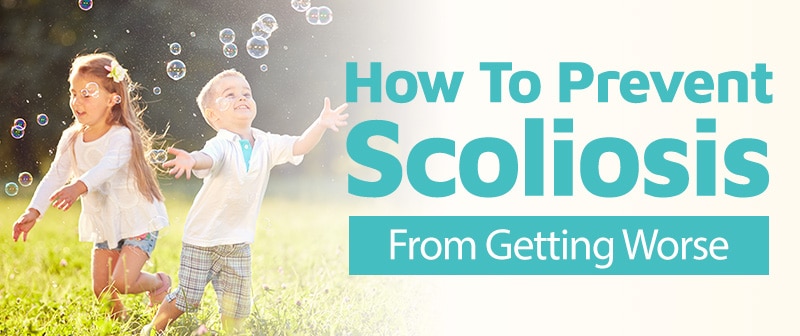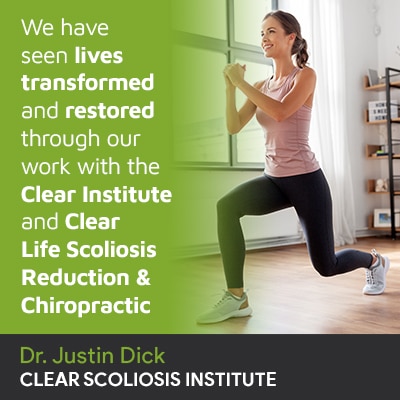
While there are many different types of scoliosis, the most prevalent is adolescent idiopathic scoliosis (AIS). This type of scoliosis is known to be the most common type of scoliosis affecting children between ages 10-18. AIS is found in, as many as, 4 in 100 adolescents. The more growth an individual experiences before they reach skeletal maturity, the more rapidly their curvature tends to progress. Therefore, one of the most difficult challenges to treating scoliosis, is staying ahead of its progression. Although we don’t fully understand the etiology of AIS, we know how to manage its progressive nature which is what we will discuss here. The good news is that if the bending of the spine is discovered early on, and Chiropractic care is received, we have greater success at preventing scoliosis from progressing to a debilitating state.
Scoliosis is a progressive condition that, by its very nature, can worsen over time. The best way to prevent scoliosis from getting worse is through proactive treatment applied as close to the time of diagnosis as possible; early detection increases the chances of treatment success.
The progressive nature of scoliosis is a defining characteristic of the condition, and regardless of type or patient age, scoliosis is virtually guaranteed to get worse.
As scoliosis is a structural spinal condition involving the development of an unnatural sideways spinal curve, with rotation, and a minimum Cobb angle measurement of 10 degrees, progression means the unnatural spinal curve is increasing in size and the spine is becoming increasingly more misaligned.
In a healthy spine, the vertebrae (bones of the spine) are stacked on top of one another in a straight and neutral alignment, but when the spine develops an unnatural curve, the affected vertebrae are no longer aligned with the rest of the spine, and a misaligned spine will not function optimally.
As a progressive condition, scoliosis is highly variable, meaning no two cases are the same, necessitating the customization of effective treatment plans.
Part of the diagnostic process involves further classifying conditions based on important patient/condition variables, condition severity being a key factor.
Condition severity is determined by a measurement known as Cobb angle, which is taken during an X-ray and involves drawing intersecting lines from the tops and bottoms of the most-tilted vertebrae at the apex of the curve.
The resulting angle is measured in degrees and places conditions on a severity scale of mild to moderate and severe. The severity scale is as follows:
As you can see from the range of Cobb angle measurements, the severity spectrum for scoliosis is vast. Early detection and diagnosis is a key aspect of effective treatment and ultimate prevention of progression. While there is no definitive way to determine a patient’s rate of progression, there are certain patient/condition variables that indicate likely progressive rates, such as age.

The idiopathic classification means this form is not clearly associated with a single clear causative source; idiopathic scoliosis is, instead, considered multifactorial, meaning caused by the combination of multiple factors that can vary from person to person. We have not found a specific gene that indicates scoliosis. However, we know this is familial, has a higher likelihood that it runs in the family.
In fact, 80 percent of known diagnosed cases are idiopathic, with the remaining 20 percent having known causes and falling into one of the following classifications: neuromuscular, congenital, degenerative, or traumatic scoliosis.
While all forms of scoliosis are progressive, children and adolescents diagnosed with scoliosis are at risk for rapid-phase progression because of the stage of growth they are in, or entering into.
As growth is the number-one trigger for progression, puberty and scoliosis growth are clearly connected; the rapid and unpredictable growth spurts associated with puberty put adolescents at risk for faster rates of progression.
Along with increasing condition severity comes escalating symptoms such as postural changes and pain (more common in adults), and the possibility of more invasive treatment needed in the future.
As the telltale signs of scoliosis in adolescents, postural changes involve a disruption to the body’s overall symmetry, caused by the uneven forces introduced by the condition; these commonly include uneven shoulders, hips, and the development of a rib arch.
An aspect of living with scoliosis that can be overlooked is the emotional/psychological component, and this is another reason that preventing progression is so important.
While every case is unique, as is each patient’s response to the condition, in general, adolescents don’t want to be set apart from their peers in terms of appearance and gait; the more severe a condition gets, the more noticeable it becomes, and the more likely it is to cause issues with negative self image, depression, and even suicidal thoughts.
As mentioned earlier, while there are no treatment guarantees, early detection does increase chances of treatment success, but this benefit is only available if combined with proactive treatment.
In order to clearly understand what it means to actively treat scoliosis, we must first understand that there are two approaches to treatment: traditional and conservative.
It’s important to understand the difference between the two main treatment approaches because they offer patients very different potential outcomes.
While the traditional treatment approach is considered passive, and may include considerable “watching and waiting” to see if the condition will progress and if so, how fast. This approach doesn’t offer any options to work on stopping the patient’s curve from getting worse. The conservative approach, which is what we, at CLEAR utilize, is seen as more of an active treatment approach.
Also known as chiropractic-centered and/or functional, conservative treatment strives to preserve the health and function of the spine and sees mild scoliosis as a chance to proactively reduce/maintain the curvature.
As scoliosis is statistically progressive, we know it’s going to get worse at some point. Treating a mild scoliotic curve is less complex as the spine is still flexible and the body has not yet had time to adjust to the unnatural curve’s presence.
As scoliosis progresses, the spine can become more rigid, especially in adults who have reached skeletal maturity, and once that happens, it’s going to be harder to achieve a curvature reduction; a rigid spine is going to be less responsive to treatment.
As a CLEAR-Certified Scoliosis Chiropractor at Clear Life Scoliosis Reduction and Chiropractic, we believe in integrating different treatment modalities for the most customized and specific results. Our treatment plans, based on our x-rays and a physical examination, are individualized for each patient.

A variety of condition-specific exercises are used. We help patients increase core strength so the spine is optimally supported and stabilized; it’s not just the spine that’s responsible for maintaining its natural curvatures and alignment, but also its surrounding muscles.
Through the use of ultra-corrective bracing like the ScoliBrace, we can augment treatment results by working towards a curvature reduction and encouraging better body positioning.
Part of the CLEAR treatment protocol, that we use at Clear Life Scoliosis Reduction & Chiropractic, is to increase chances of treatment success by starting proactive treatment as early in the condition’s progressive line as possible: working towards preventing increased condition severity, escalating symptoms, and avoiding the need for more invasive treatment in the future.
In the traditional approach, prior to reaching the surgical-level threshold, traditional bracing is utilized. This approach funnels patients towards spinal fusion surgery. While all surgeries come with their share of risks, spinal fusion is costly, invasive, and carries some heavy side effects and risk of complications. Once a surgical fusion is performed, there are few options to help outside of another surgery.
Particularly with AIS, the benefits of early detection, proactive treatment, and careful monitoring allow us to evaluate how the spine responds to treatment. It further allows us to determine utilization of various treatment modalities/methods through a customized approach for specific results.
When it comes to preventing scoliosis from getting worse, the answer is proactive treatment, and the right time to start proactive treatment is always now.
In terms of treatment, the important thing to remember is that not all approaches are proactive, such as the traditional treatment approach that’s more accurately described as passive and/or reactive.
Once a scoliosis diagnosis is reached, the most important decision is how to treat the condition moving forward, as well as the timeliness of that treatment.
A traditional treatment approach may be of benefit for some patient, it generally values “watching and waiting”, traditional bracing, and in most cases, funnels patients towards spinal fusion once a certain severity level has been reached. Conservative treatment offers patients an active and proactive approach that culminates in a different potential result.
In order to stay ahead of a condition’s progression, initiating treatment as close to the time of diagnosis provides an opportunity to proactively manage through prevention: it further reduces progression and condition severity. This is done in an effort to reduce the likelihood of more invasive forms of treatment, like surgery.
As a CLEAR-certified scoliosis chiropractor, we, at Clear Life Scoliosis Reduction & Chiropractic, comprehensively assess conditions so we can craft fully-individualized treatment plans to address patient-specific patient conditions. No two patients will experience the same treatment. The good news is that if scoliosis is discovered early on, and Chiropractic care by a Clear-Certified Scoliosis Chiropractor is received, it can help limit the scoliosis from progressing to a debilitating state!

CLEAR provides a unique and innovative way of understanding scoliosis. Sign up to receive facts and information you won’t find anywhere else.

I am just reaching out at to you. I am a 43 year woman with severe scoliosis. The pain is unbearable. I cannot afford a chiropractor. I was wondering what else I can do. I do workout at my home gym as much as I can. I am in so much pain. When I seen a chiropractor it helped but with my low paying job and the economy things are hard. Thank you for the time on taking to read this.
Hello, Brooke.
It is important to stay active, however, depending upon what you are doing as part of your workout, you could be causing more pain. Our CLEAR Scoliosis Institute certified Doctors customize exercises per patient so they are most effectively stabilizing their spine versus harming it. These exercises, stretches, etc. are customized for each individual patient and are based on their specific x-rays, so unfortunately they are not something that can be conveyed as a general "you have scoliosis, you do these exercises". I suggest contacting your primary care provider to see if there is something they can do to help with pain management until you are in a better position financially to visit one of our clinics and have your scoliosis addressed. Please let us know if we can be of further assistance. Best of luck.